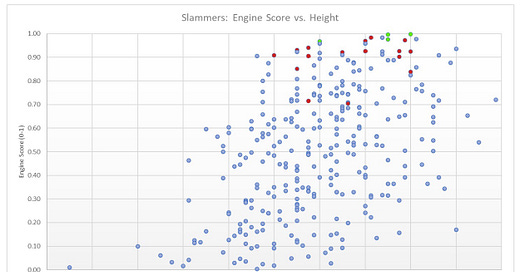What is an Engine Score?
This is our baseball performance metric and good things happen when it goes up.
Amidst the recent barrage of tweets coming from @SlammersAD (if you don’t see yourself, there’s more coming), you have probably noticed an Engine Score associated with most players. We have been tooling around with the Engine Score (previously referenced as a Performance Score) since the fall and what we have developed is an index on a 0-1.00 that we have derived from the Loden Sports Rebound Jumps test and a rotational med ball throw.
Where Does Velocity Come From?
There are four primary variables for increasing velocity – in no particular order: the length of the athlete (height and wingspan, essentially), proper throwing mechanics (a good mover can efficiently use all they got), power in rotation, and power in the legs.
At Slammers, we measure progress across a number of key indicators in what we’re trying to improve in the physical profile of each athlete - knowing that the physical profile directly impacts what happens on the baseball field. The Engine Score helps take this to another level.
While the Loden Score alone is a strong indicator for throwing velocity and exit velocity, the Engine Score is a bit more specific to rotational athletes as it combines both the jump power metric from the Loden Sports Rebound Jumps test with how an athlete performs on their rotational med ball throw (from their dominant side). The Engine Score metric gives an even stronger signal for expected velocity performance on-field for baseball (and softball) players. It’s almost a perfect correlation.
How about a demonstration from Big Leaguer, Bryan King?
BK flew the 6 lb. med ball, 51 1/4 ft. on his dominant side. He then registered 71.1 Loden Power Points on his Rebound Jumps. That combination was good for an Engine Score of .97. As of this publishing, Bryan has two clean innings on his record with the Houston Astros and we’re very proud of him.
Since the fall, over 300 unique athletes over the age of 15 have attained an Engine Score. This includes high school guys, college guys, and our pro guys. We even used it as a measure of improvement for AVP this past winter. You can check that out here. We saw improvement across the board in both throwing velocity and Engine Score; and, some of the largest velocity gains coincided with some of the largest Engine Score gains (looking at you, Owen Elser).
The plot below shows over 300 unique athletes that Slammers has tested over the age of 15. Engine Score on the y axis. Athlete height on the x axis.
Green dots are our pro guys. Red dots are our current and committed D1 guys. Everyone over the age of 15 who completed a Loden Sports Eval is on there, so download the file below (or go to your tweet); find your height; find your Engine Score; and find your dot.




